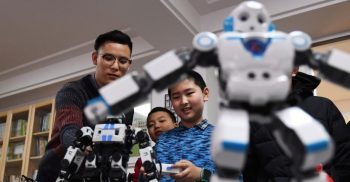
Robotics spending in the Asia-Pacific region excluding Japan (APEJ) will surpass US$130 billion by 2021, according to a report by the market research firm IDC.
The report, IDC FutureScape: Worldwide Robotics 2018 Predictions – Asia/Pacific (Excluding Japan) Implications, includes predictions on robotic development and adoption in the region, the Hong Kong Economic Journal said.
Over the five-year period from 2017 to 2021, robotic spending is expected to hit US$133 billion, accounting for 60 percent of the global robotics market in 2021.
Along with the increased spending is the rapid development of the technology, which is expected to incorporate embedded and/or cloud-based artificial intelligence (AI), said Dr. Jing Bing Zhang, research director of Worldwide Robotics and Asia/Pacific Manufacturing Insights at IDC Asia/Pacific.
This technology will produce intelligent robots, which are characterized by “their ubiquitous sensing and connectivity, cyber-physical fusion, autonomous capabilities, and more human-friendly multi-mode interaction”, Zhang said.
“This development will have a profound impact on industrial robots and service robots, both commercial and consumer.”
Zhang also unveiled three of the top 10 predictions and major robotics trends that will present new opportunities and challenges to IT leaders in 2018 and beyond.
IDC said 40 percent of newly installed industrial robots in the APEJ market will be mounted with at least one of the intelligent features, including predictive analytics, health condition awareness, self-diagnosis, peer learning, and autonomous cognition.
It is also predicted that 35 percent of the top 100 APEJ retailers will be using or piloting robots, helping bring down the cost of goods delivery by around 20 percent.
Zhang also foresees that 25 percent of A2000 manufacturers will have set up cyber-physical robotic systems, leading to 10 to 20 percent improvement in productivity.
The article was originally published on www.ejinsight.comand can be viewed in full
 (0)
(0) (0)
(0)Archive
- October 2024(44)
- September 2024(94)
- August 2024(100)
- July 2024(99)
- June 2024(126)
- May 2024(155)
- April 2024(123)
- March 2024(112)
- February 2024(109)
- January 2024(95)
- December 2023(56)
- November 2023(86)
- October 2023(97)
- September 2023(89)
- August 2023(101)
- July 2023(104)
- June 2023(113)
- May 2023(103)
- April 2023(93)
- March 2023(129)
- February 2023(77)
- January 2023(91)
- December 2022(90)
- November 2022(125)
- October 2022(117)
- September 2022(137)
- August 2022(119)
- July 2022(99)
- June 2022(128)
- May 2022(112)
- April 2022(108)
- March 2022(121)
- February 2022(93)
- January 2022(110)
- December 2021(92)
- November 2021(107)
- October 2021(101)
- September 2021(81)
- August 2021(74)
- July 2021(78)
- June 2021(92)
- May 2021(67)
- April 2021(79)
- March 2021(79)
- February 2021(58)
- January 2021(55)
- December 2020(56)
- November 2020(59)
- October 2020(78)
- September 2020(72)
- August 2020(64)
- July 2020(71)
- June 2020(74)
- May 2020(50)
- April 2020(71)
- March 2020(71)
- February 2020(58)
- January 2020(62)
- December 2019(57)
- November 2019(64)
- October 2019(25)
- September 2019(24)
- August 2019(14)
- July 2019(23)
- June 2019(54)
- May 2019(82)
- April 2019(76)
- March 2019(71)
- February 2019(67)
- January 2019(75)
- December 2018(44)
- November 2018(47)
- October 2018(74)
- September 2018(54)
- August 2018(61)
- July 2018(72)
- June 2018(62)
- May 2018(62)
- April 2018(73)
- March 2018(76)
- February 2018(8)
- January 2018(7)
- December 2017(6)
- November 2017(8)
- October 2017(3)
- September 2017(4)
- August 2017(4)
- July 2017(2)
- June 2017(5)
- May 2017(6)
- April 2017(11)
- March 2017(8)
- February 2017(16)
- January 2017(10)
- December 2016(12)
- November 2016(20)
- October 2016(7)
- September 2016(102)
- August 2016(168)
- July 2016(141)
- June 2016(149)
- May 2016(117)
- April 2016(59)
- March 2016(85)
- February 2016(153)
- December 2015(150)
